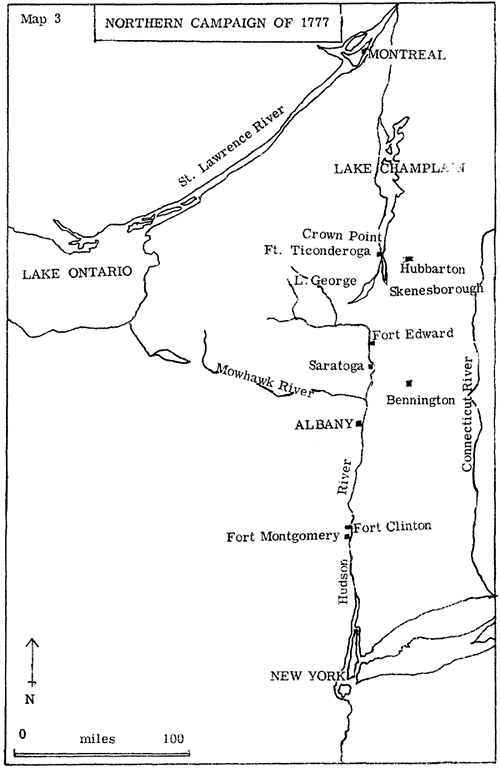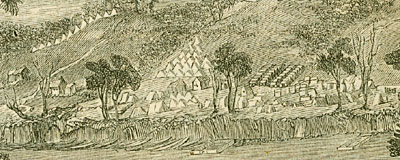1777 and the northern campaign
In 1776 an American army under Benedict Arnold had invaded Canada, intending to drive the British out of Quebec and welcome Canada as the Fourteenth Colony. This expedition was defeated by Governor Carleton at Quebec, and he followed the retreating Americans as far as Lake Champlain. The arrival of winter and unseasoned reinforcements together prevented an offensive into America in 1776, but the new commander, General John Burgoyne, spent most of the winter preparing for a campaign along Lake Champlain the following year.
In early June 1777 the British army was assembled at the north end of Lake Champlain, advanced and took Forts Ticonderoga and Crown Point without any difficulty, and then attempted to push through to the Hudson River at Albany. The hundred miles or so separating these two places was the watershed of the Sorel and Hudson river systems, heavily wooded and with a series of hill ridges running parallel to the line of march. Towards the end of July the American resistance began to stiffen. An early skirmish at Hubbarton had required Dr. Hayes' services [see Document 3], but after the battles of Bennington in August and Saratoga in September the advance ground to a halt. American strength increased around the beleaguered British Army.
For most of the campaigns of 1777 Sir Henry Clinton was a bystander. He was in England for much of the first half of the year. He took no part in the battles of Trenton and Princetown, or the planning of the Northern campaign and the advance to Philadelphia on which he now found Sir William Howe embarked. Sir Henry arrived back in America to find that he was in effect the commander of the New York garrison of 7,000 men, and that the British armies were fighting two campaigns which were completely unco-ordinated. He feared above all that this split of forces would allow the Americans to make an attack on New York and its environs, which would reverse all the gains of the previous year. The key to the Northern campaign was not possession of Canada and Albany, but control of the Hudson River, by the capture of the highland forts guarding it.
During July and August, although Sir Henry feared a reverse, he had no definite news either from Philadelphia or Canada. By the beginning of September Clinton learned that instead of being in Albany on the 23rd August, as he had expected, General Burgoyne had only got as far as Saratoga some fifty miles short of his objective. It became increasingly obvious that help was required from New York, at the very least a diversionary attack. The problem was that Sir Henry did not dare risk depleting the New York garrison; so any operation had to be carried out with less than 2,500 men.

By the end of September the arrival of reinforcements from Britain allowed Sir Henry to take a gamble. His force of 3,000 men embarked on the 3rd October and attacked the highland forts Montgomery and Clinton. By the 8th October the Hudson Highlands were in British hands, and the route from Albany to the South open, [see Document 4]. This success was no longer enough to save Burgoyne and his army, which had been defeated at the second battle of Saratoga on the previous day, and begun to retreat towards Canada. A week later the northern army surrendered. Any hopes which Sir Henry Clinton might have had of saving something from the disaster were dashed by a letter from Sir William Howe (still in Philadelphia and unaware of Burgoyne's defeat) requesting the detachment of 4,000 men to him as reinforcements.
A major explanation for Burgoyne's disaster must be the lack of a concerted campaign plan for 1777. It convinced the Americans that Britain could be beaten and the French that they had little to lose by joining the fight as America's ally.

General Burgoyne's army encamped on the Hudson river, 1777
From The Popular History of England by Charles Knight, Vol. VI (London: Bradbury and Evans, 1860)
Next page: Battle of Monmouth, N.J., 1778-Autumn 1779